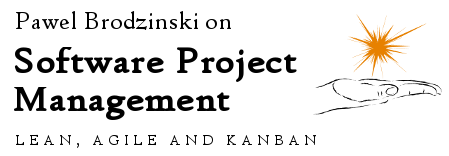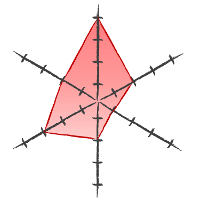One of interesting bit of work that is happening in Lean Kanban community is Hakan Forss’ idea of Kanban Kata. Kanban Kata is an attempt to translate ideas of Toyota Kata to Kanban land.
A simplified teaser of Kanban Kata is that we set a general goal, a kind of perfect situation we unlikely ever reach. Then we set short term, well-defined, achievable step that brings us closer toward the goal. Finally, we deliberately work to make the step, verify how it went and decide on another step. Learn more about Kanan Kata from Hakan’s blog.
Honestly, I was a bit skeptical about the approach. One thing that seemed very artificial for me was the advice how we should define short term steps that lead us toward the ultimate goal. “Improve lead time by 10% in a month.” What kind of goal is that? Why 10%? Why in a month? How should we feel if we manage to improve it only by 8%? Should we cease to continue improvements when reaching the goal after a week?
I know that these questions assume treating the goal literally and not very much common sense but you get what you measure. If you set such measurements, expect that people would behave in a specific way.
I think the missing bit for me was applying some sort of relativity to Kanban Kata. Something that would address my aversion to orthodoxy. Something that would make the application context broader. I found the missing link in David Anderson’s keynote at London Lean Kanban Day.
Interestingly enough, the missing link is my own work on maturity of Kanban implementations. Yes, it seems I need David to point me usefulness of stuff that I did.
The context of my work on depth of Kanban implementation is that instead of trying to use sort of a general benchmark I simply used “where we would like to be” as a reference point to judge where we are right now. In short: I’m not going to try to compare any of my teams to, e.g. David Anderson’s team at Corbis. Instead I want any team to understand where their own gaps are and work toward closing them.
Such an approach perfectly suits setting the goal of Kanban Kata, doesn’t it?
I mean, instead of having this artificial measure of improvements we have internally set end state which is resultant of opinions of all the team members. On one hand this approach let us avoid absolute assessments, which rarely, if ever, help as they ignore the context. On the other it helps to set meaningful goals for Kanban Kata-like improvements.
Relativity requires a team to understand the method they are trying to apply, but I would argue that if the team doesn’t understand their tools they’re doomed anyway.


 Subscribe RSS feed
Subscribe RSS feed Follow on Twitter
Follow on Twitter Subscribe by email
Subscribe by email



2 comments… add one
Pawel, I may be biased because I’ve been involved in complex A3s recently, but I’ve found A3 Thinking to be very helpful to the Improvement Kata. The systematic process of filling out the A3 sections can help create shared understanding of the Current Condition, the problem (gap) and identify the appropriate Challenge and useful Target Conditions.
For example, when people have shared understanding of the Current Condition (and the corresponding sections of an A3 are filled out), they can move on to formulating the problem as a gap and identifying the metric used to measure progress toward closing the gap. Thus the target and the metric come from the people, not externally, and may be different from the existing KPIs.
When the group specifies the Target Condition – improve (metric) to X by day Y – that also specifies the expiration date on the metric. Specifying the date is important, because it may affect effectiveness and feasibility of countermeasures (A3 makes that explicit).
@Alexei – Good point. I’m not that much into A3 these days so it’s not my natural context.
I would, however, point that I often struggle with defining explicit measures for things like (dis)satisfaction with this or that current condition. Even more so, given that it changes over time.
If we take maturity of Kanban implementation as a context, on one hand the team should work to go toward “more mature” end of scale in areas they find the most painful or most important. On the other hand a coach or a leader should care about getting deeper understanding of the method which would likely pull relative assessment toward “less mature” end of scale, e.g. we are doing the same thing but know we know the potential of growth is bigger so, relatively, we aren’t as far as we thought we were.
This may be addressed by having expiration date of a metric in A3. It adds another artificial bit to the whole equation. I mean, we want to improve something concrete in two weeks. What if it happens after 16 days?
I’m aware that I have a tendency to relativize such stuff, but then I do it consciously and on purpose. A relative measure will be constantly adjusted to current condition and target condition is always some kind of derivative of current condition thus my thinking is it should be constantly evolving as well.
Anyways, I think A3 thinking is a very suitable tool to be used in the context of Kanban Kata, so thank you as I find the comment highly complimentary to the post.